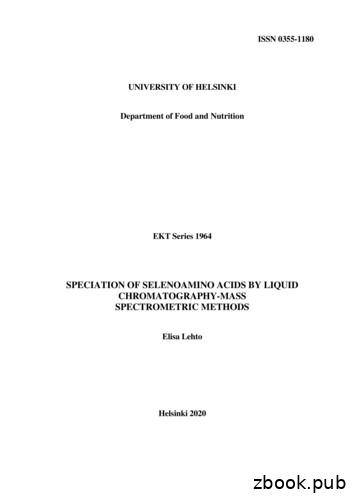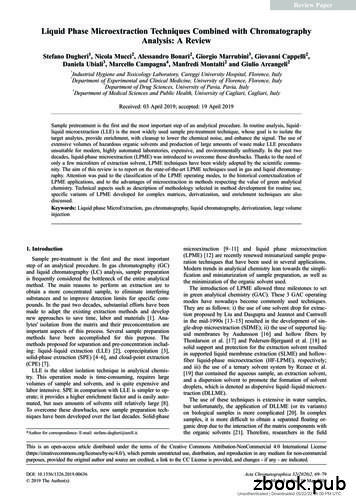Liquid Chromatography - University Of Florida
Liquid Chromatography1. Introduction and Column Packing Material2. Retention Mechanisms in Liquid Chromatography3. Method Development4. Column Preparation5. General Instrumental aspects6. Detectors(Chapter 4 and 5 in The essence of chromatography)
Retention Mechanisms in Liquid Chromatography
A. Adsorption Chromatography1. A LC technique which separates solutes based on their adsorption toan un-derivatized solid particles is known as adsorptionchromatography, or liquid-solid chromatography.2. Adsorption chromatography was the first type of column liquidchromatography developed (Tsweet, 1903). However, it iscurrently not widely used as other LC methods.3. Like gas-solid chromatography, supports in adsorptionchromatography have the potential disadvantages of having verystrong retention of some solutes and may be even cause catalyticchanges in solutes. However, this is not as a big problem in LC as itis in since the mobile phase composition can be varied to controlsolute retention and lower operating temperature of LC make catalyticreactions less likely than in GC.
4. One advantages of adsorption chromatography, as is also true forGSC, is that it is able to retain and separate some compounds that cannot be separated by other methods. One such application is in theseparation of geometrical isomers.5. Mechanism(a) Retention of solute in adsorption chromatography can be viewedas solute A displacing n moles of solvent M from a surface.Amp nMspAsp nMmp
(b) Based on this model, the value of k for solute A can be given bylog(k) α’ (S0 – Asε0) log(VaWs/Vm)Where: Va Volume of adsorbed solvent in column per gram of supportWs Weight of support in columnVm Volume of bulk mobile phase in column, or void volumeAs Area on surface occupied by solute Aε0 adsorption energy of M per unit area of supportα’ Adsorption activity parameter ( α’ as support polarity)S0 Adsorption energy of A on support
Solvent strength ε0 can be tuned using a two-solvent strategy
6. Solid Supports
B. Partition Chromatography(1) Partition chromatography, or liquid-liquid chromatography is aChromatographic technique in which solute are separated based ontheir partition between a liquid mobile phase and a liquid stationaryphase coated on a solid support.Phase 2Phase 2Phase 1Phase 1(2) The support material used in partition chromatography is usuallysilica. Un-bonded and banded stationary phase.(3) Mechanism:The retention of solute in partition chromatography is given by:k KD (Vs/Vm)
(4) Applications of partition Chromatography(5) Bonded stationary phaseNormal-phase LC (stationary phase is more polar that mobile phase)Reversed-phase LC (stationary phase is less polar that mobile phase)
(a) Normal phase liquid Chromatography (NPLC)i. Since NPLC has a polar stationary phase, it retains polar compoundsMost strongly. However,It may be used forSeparation of non-polarAs well as polarcompounds
ii. Strong mobile phase in NPLC is polar liquids, such as water ormethanol.Weak mobile phase in NPLC is non-polar liquids, such as an organicsolvent.(b) Reversed-phased liquid chromatography (RPLC) is another type ofpartition chromatography.
i. Effect of hydrocarbon chain length
ii. Strong mobile phase in RPLC is non-polar liquidweak mobile phase in RPLC is polar liquidiii. Differences in retention between NPLC and RPLCSolutesphenolnitrobenzeneToluene
(6) Retention mechanisms: (solvation parameter model/Kamlet-Taft parameters)HHHlog k c mVx rR2 sπ2 aΣα2 bΣβ2(Liquid chromatography)
Mobile phases effects on system constants (I)HHHlog k c mVx rR2 sπ2 aΣα2 bΣβ2
Mobile phases effects on system constants (II)HHHlog k c mVx rR2 sπ2 aΣα2 bΣβ2
Solvent-programmed LC
Retention Mechanisms in Liquid Chromatography
1. A LC technique which separates solutes based on their adsorption to an un-derivatized solid particles is known as adsorption chromatography, or liquid-solid chromatography. 2. Adsorption chromatography was the first type of column liquid chromatography developed (Tsweet, 1903). However, it is currently
2.3.1 Liquid chromatography (LC) 20 Size-exclusion chromatography (SEC) 20 Ion-exchange chromatography (IEC) 22 Reversed-phase chromatography (RP) 23 Reversed-phase ion pairing chromatography (RPIP) 24 2.3.2 Gas chromatography (GC) 25 2.3.3 Electrophoretic techniques 25 2.3.4 Isotope dilution analysis (IDA) 26 3 EXPERIMENTAL RESEARCH 27 Aims 27
Chromatography 481 27.4.2 Partition (Liquid–Liquid) Chromatography 482 27.4.2.1 Introduction 482 27.4.2.2 Coated Supports 483 27.4.2.3 Bonded Supports 483 27.4.3 Ion-Exchange Chromatography 483 27.4.4 Size-Exclusion Chromatography 485 27.4.5 Affinity Chromatography 488 27.5 Analys
Gel filtration chromatography-An Overview Larger particles come out first, while smaller particles come in later fractions Biochemistry of Medics 33. 5) Affinity chromatography . High performance liquid chromatography-Significance Biochemistry of Medics 39. High performance liquid chromatography- Apparatus Biochemistry of Medics 40.
liquid chromatography, however, should be classified into two groups, non-aqueous hydrophilic (normal-phase) and aqueous hydrophilic liquid chromatography. The latter is prevalent; however, this technique is often misinterpreted as normal-phase liquid chromatography. Therefore, it is crucial to carefully select the appropriate terminology.
1. Theory of liquid chromatography. High performance liquid chromatography (HPLC) is a technique for separating analytes dissolved in a liquid, mobile phase by using their specific interaction with a stationary phase (chromatography column). Depending on the type of interaction of the sample molecules with both mobile and stationary phases,
Keywords: Liquid phase MicroExtraction, gas chromatography, liquid chromatography, derivatization, large volume injection 1. Introduction Sample pre-treatment is the first and the most important step of an analytical procedure. In gas chromatography (GC) . Overview of the Results, and Classification of the Liquid Phase MicroExtraction (LPME .
“Laboratory Chromatography Guide” – A close look at preparative liquid chromatography The present “Laboratory Chromatography Guide” is dedicated to preparative liquid chromatography, a common purification techni-que in most chemical or life science laboratories. T
Implication zootechnique du menthol cristallisé comme additif. alimentaire chez le poulet de chair. E. AZEROUAL. 1, M. OUKESSOU. 2, K. BOUZOUBAA. 2, A. MESFIOUI. 1, B. BENAZZOUZ & A. OUICHOU (Reçu le 15/04/2012; Accepté le 18/06/2012) Résumé. Le menthol est utilisé pour ses vertus aromatiques, culinaires, cosmétiques et médicinales. Chez l’homme, il est employé contre les . troubles .






















